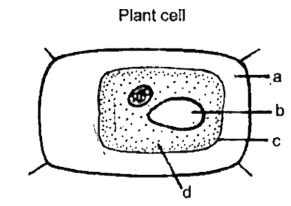A plant cell is kept in a hypotonic solution. What will happen to the solute potential of this cell?
To determine what happens to the solute potential of a plant cell when it is placed in a hypotonic solution, we can follow these steps:
1. Understanding Hypotonic Solution:
- A hypotonic solution is one that has a lower concentration of solutes compared to the inside of the plant cell. This means that the concentration of water (solvent) is higher outside the cell than inside.
2. Osmosis Process:
- When a plant cell is placed in a hypotonic solution, water will move into the cell through osmosis. Osmosis is the movement of water from an area of higher water concentration (hypotonic solution) to an area of lower water concentration (inside the cell).
3. Effect on Cell:
- As water enters the plant cell, it causes the cell to swell and become turgid. This is because the cell wall can withstand the pressure created by the influx of water, preventing the cell from bursting.
4. Change in Solute Potential:
- The solute potential (Ψs) of a solution is a measure of the potential energy of solutes in a solution. When water enters the cell, the concentration of solutes inside the cell becomes diluted because the amount of water increases while the amount of solute remains constant.
- As a result, the solute potential of the cell decreases. This is because solute potential is inversely related to solute concentration; as the concentration of solutes decreases, the solute potential becomes less negative (or increases).
5. Conclusion:
- Therefore, when a plant cell is placed in a hypotonic solution, the solute potential of the cell decreases due to the dilution of solutes as water enters the cell.
Final Answer:
The solute potential of the plant cell will decrease when it is kept in a hypotonic solution.
---
- A hypotonic solution is one that has a lower concentration of solutes compared to the inside of the plant cell. This means that the concentration of water (solvent) is higher outside the cell than inside.
- When a plant cell is placed in a hypotonic solution, water will move into the cell through osmosis. Osmosis is the movement of water from an area of higher water concentration (hypotonic solution) to an area of lower water concentration (inside the cell).
- As water enters the plant cell, it causes the cell to swell and become turgid. This is because the cell wall can withstand the pressure created by the influx of water, preventing the cell from bursting.
- The solute potential (Ψs) of a solution is a measure of the potential energy of solutes in a solution. When water enters the cell, the concentration of solutes inside the cell becomes diluted because the amount of water increases while the amount of solute remains constant.
- As a result, the solute potential of the cell decreases. This is because solute potential is inversely related to solute concentration; as the concentration of solutes decreases, the solute potential becomes less negative (or increases).
- Therefore, when a plant cell is placed in a hypotonic solution, the solute potential of the cell decreases due to the dilution of solutes as water enters the cell.
The solute potential of the plant cell will decrease when it is kept in a hypotonic solution.
Topper's Solved these Questions
- TRANSPORT IN PLANTS BOOK - ICSECHAPTER - TRANSPORT IN PLANTS EXERCISE - TEST YOUR PROGRESS (SHORT/LONG ANSWER TYPE QUESTIONS)
34 Videos
- TRANSPORT IN PLANTS BOOK - ICSECHAPTER - TRANSPORT IN PLANTS EXERCISE - TEST YOUR PROGRESS (HIGHER ORDER THINKING SKILLS QUESTIONS (HOTS))
9 Videos
- TRANSPORT IN PLANTS BOOK - ICSECHAPTER - TRANSPORT IN PLANTS EXERCISE - TEST YOUR PROGRESS (State whether the following statements are true or false)
16 Videos
- THE LIVING WORLD BOOK - ICSECHAPTER - THE LIVING WORLD EXERCISE - Ncert Exercises (Differentiate Between )
4 Videos
Similar Questions
Knowledge Check
When a cell is placed in a hypotonic solution :
Asolute exits the cell to equalize the concentration on both sides of the membraneBwater exits the cell toward the area of lower solute concentrationCwater enters the cell toward the area of higher solute concentrationDsolute exits and water enters the cellWhen a cell is placed in a hypertonic solution:
Asolute exits the cell to equalize the concentration on both sides of the membraneBwater exits the cell toward the area of lower solute concentrationCwater exits the cell toward the area of higher solute concentrationDsolute exits and water enters the cellIf a cell is placed in an isotonic solution, what will occur?
ASalts will move into the cell from the surrounding solutionBWater will move into the cell from the surrounding solutionCSalts will move out of the cell into the surrounding solutionDNone of the above will occur
A cell placed in hypotonic solution will
View SolutionStudy the diagram given alongside showing a plant cell kept in a strong sugar solution.

What will happen to this cell if it is kept in water?
View SolutionContents of vacuole does not contribute to the solute potential of the cell
View SolutionA cell placed in hypertonic solution will :
View SolutionIn hypertonic solution the water potential of cell
View Solution
